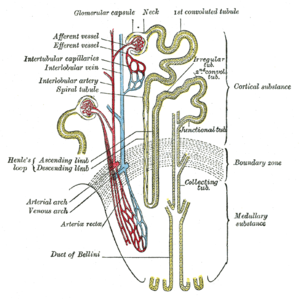Bartter syndrome
| Bartter syndrome | |
|---|---|
 |
|
| Scheme of renal tubule and its vascular supply. | |
| Classification and external resources | |
| Specialty | endocrinology |
| ICD-10 | E26.8 |
| ICD-9-CM | 255.13 |
| OMIM | 601678 241200 607364 602522 |
| DiseasesDB | 1254 |
| MedlinePlus | 000308 |
| eMedicine | med/213 ped/210 |
| MeSH | D001477 |
| Orphanet | 93604 |
Bartter syndrome is a rare inherited defect in the thick ascending limb of the loop of Henle. It is characterized by low potassium levels (hypokalemia), increased blood pH (alkalosis), and normal to low blood pressure. There are two types of Bartter syndrome: neonatal and classic. A closely associated disorder, Gitelman syndrome, is milder than both subtypes of Bartter syndrome.
In 90% of cases, neonatal Bartter syndrome is seen between 24 and 30 weeks of gestation with excess amniotic fluid (polyhydramnios). After birth, the infant is seen to urinate and drink excessively (polyuria, and polydipsia, respectively). Life-threatening dehydration may result if the infant does not receive adequate fluids. About 85% of infants dispose of excess amounts of calcium in the urine (hypercalciuria) and kidneys (nephrocalcinosis), which may lead to kidney stones. In rare occasions, the infant may progress to renal failure.
Patients with classic Bartter syndrome may have symptoms in the first two years of life, but they are usually diagnosed at school age or later. Like infants with the neonatal subtype, patients with classic Bartter syndrome also have polyuria, polydipsia, and a tendency to dehydration, but normal or just slightly increased urinary calcium excretion without the tendency to develop kidney stones. These patients also have vomiting and growth retardation. Kidney function is also normal if the disease is treated, but occasionally patients proceed to end-stage renal failure. Bartter's syndrome consists of hypokalaemia, alkalosis, normal to low blood pressures, and elevated plasma renin and aldosterone. Numerous causes of this syndrome probably exist. Diagnostic pointers include high urinary potassium and chloride despite low serum values, increased plasma renin, hyperplasia of the juxtaglomerular apparatus on renal biopsy, and careful exclusion of diuretic abuse. Excess production of renal prostaglandins is often found. Magnesium wasting may also occur. Homozygous patients suffer from severe hypercalciuria and nephrocalcinosis.
...
Wikipedia
